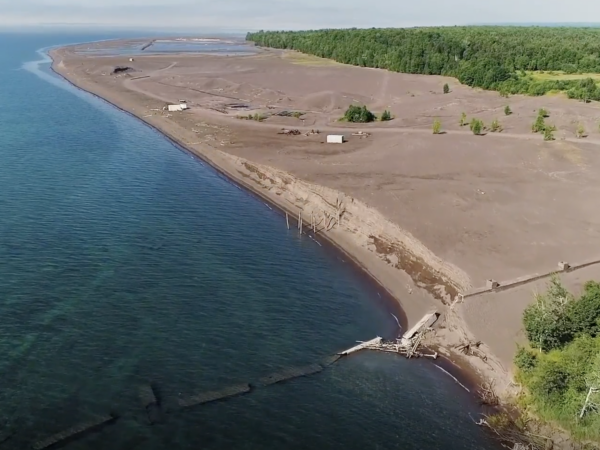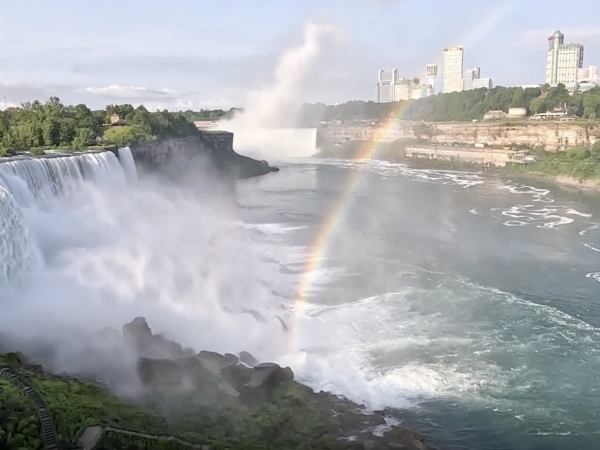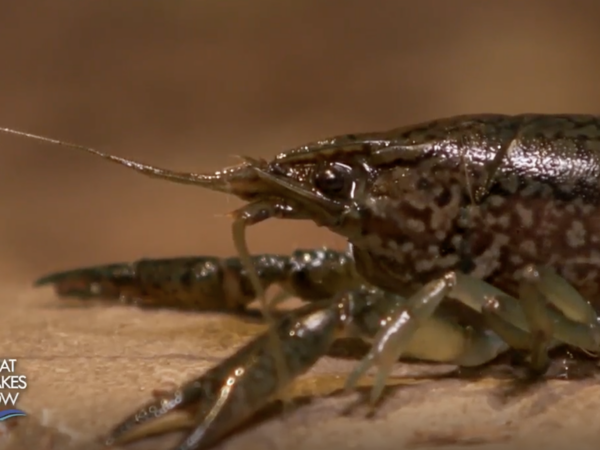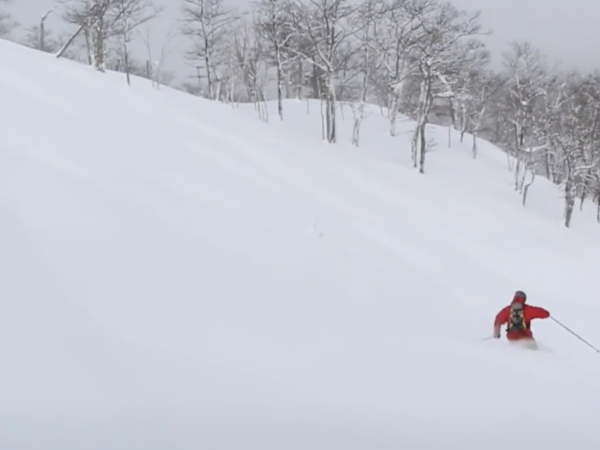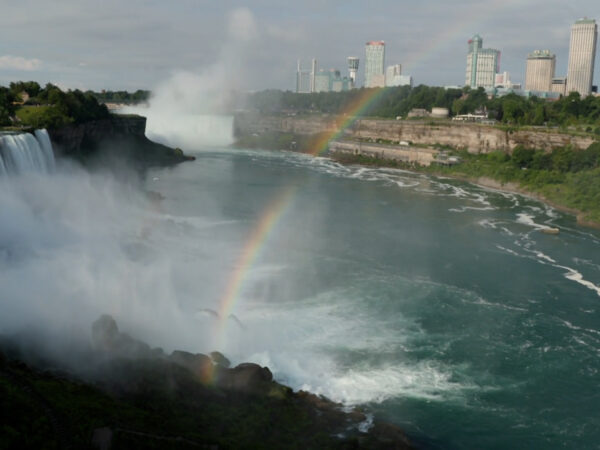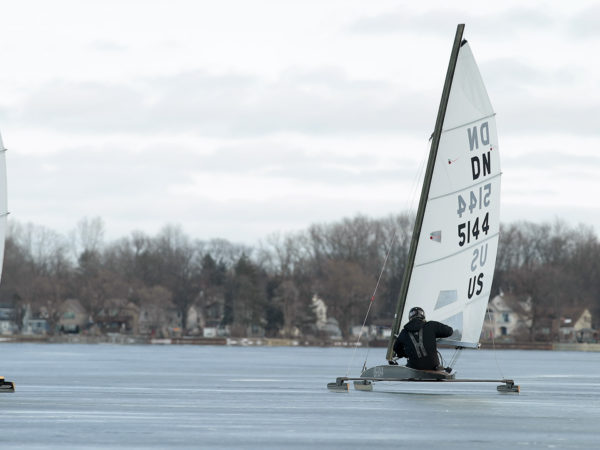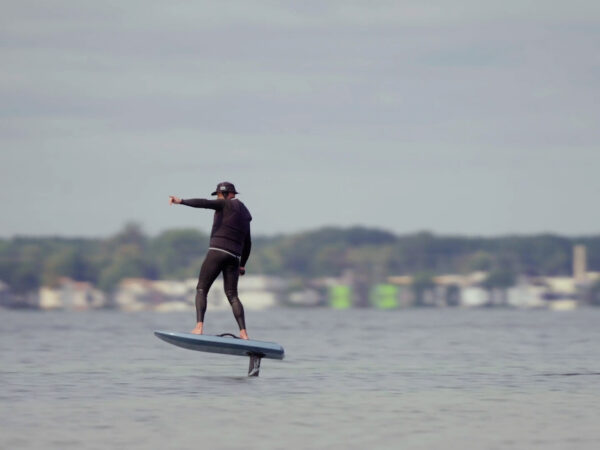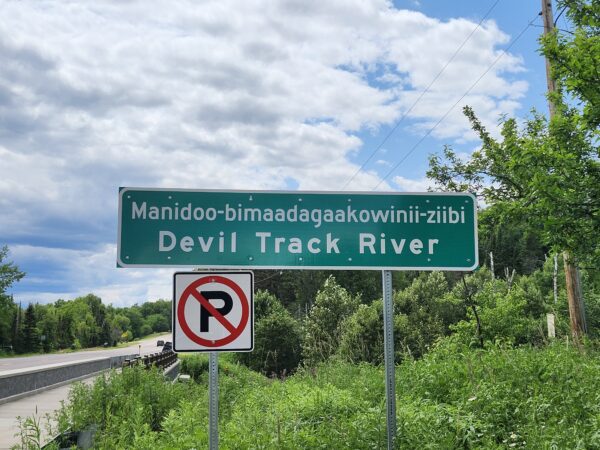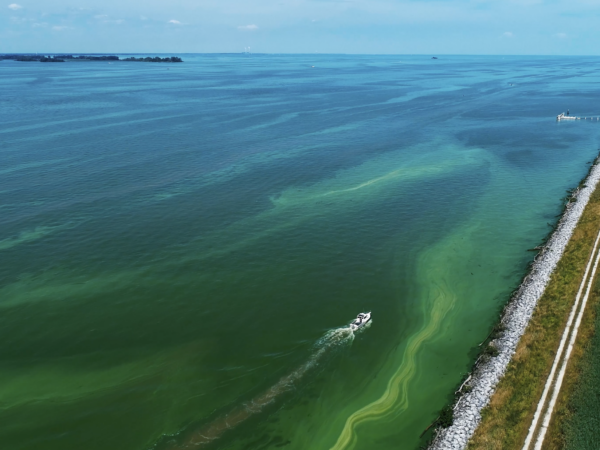IN THIS EPISODE:
In this episode of Great Lakes Now, we focus on citizen science with a look at initiatives to chart changes to the night sky, counting insect larva to measure the health of our waterways, and The Catch offers news from around the Great Lakes.
WHERE WE TAKE YOU IN MARCH
GREAT LAKES LEARNING:
Explore this month’s hands-on lesson plans designed to help your middle schoolers understand the Great Lakes — all at home or in the classroom. They’re aligned to education standards AND free to download.
Lesson Plans
Have a question about the Great Lakes or life in the region?
Ask Great Lakes Now, and if we can answer it, we might loop it into our coverage so others can learn too.
Submit Your Question
When to Watch?
Check your local station for when Great Lakes Now is on in your area.
Premieres on DPTV
Monday, March 27, at 7:30 PM
STATIONS CARRYING THE SERIES
DPTV
Detroit, Michigan
WEAO
Akron, Ohio
WNEO-TV
Alliance, Ohio
WCML-TV
Alpena, Michigan
WDCP-TV
Bad Axe, Michigan
BCTV
Bay County, Michigan
WBGU-TV
Bowling Green, Ohio
WNED-TV
Buffalo, New York
WCMV-TV
Cadillac, Michigan
WTTW-TV
Chicago, Illinois
WVIZ-TV
Cleveland, Ohio
WKAR-TV
East Lansing, Michigan
WQLN-TV
Erie, Pennsylvania
WCMZ-TV
Flint, Michigan
WGVU-TV
Grand Rapids, Michigan
WPNE-TV
Green Bay, Wisconsin
WGVK-TV
Kalamazoo, Michigan
WHLA-TV
La Crosse, Wisconsin
WHA-TV
Madison, Wisconsin
WNMU-TV
Marquette, Michigan
WHWC-TV
Menomonie-Eau Claire, Wisconsin
WMVS-TV
Milwaukee, Wisconsin
WCMU-TV
Mt. Pleasant, Michigan
WLEF-TV
Park Falls, Wisconsin
WNIT-TV
South Bend, Indiana
WCNY-TV
Syracuse, New York
WGTE-TV
Toledo, Ohio
WDCQ-TV
University Center, Michigan
WNPI-TV
Watertown, New York for Ontario signal
WPBS-TV
Watertown, New York for U.S. signal
WHRM-TV
Wausau, Wisconsin

The Globe At Night website allows citizen scientists to chart changes to the night sky as light pollution continues to brighten the sky and fewer stars remain visible.
Globe At Night
SEGMENT 1 | Tucson, Arizona and Geneva Lake, Wisconsin
The stars don’t shine as brightly as they used to, and if you live in a metropolitan area it’s getting more difficult to even see the stars at night.
That’s because of the growing problem of light pollution. How did we get here and what’s being done to preserve our night skies?
This story starts more than 100 years ago on the shores of Geneva Lake, about 40 miles west of Kenosha, Wisconsin. That’s where the sprawling Yerkes Observatory was built in 1897. The observatory was once owned and operated by the University of Chicago.
Some legendary names in the world of astronomy did research there. Among them Edwin Hubble, who proved there are millions of other galaxies out there, and even Albert Einstein paid a visit to the Yerkes Observatory in 1921. “He made sort of a rock star fame tour of the US and he wanted to go to two places most of all: Niagara Falls and the Yerkes Observatory,” said Walt Chadick, Director of Programs and External Affairs at Yerkes. “It remains the largest refracting telescope in the world.”
Indeed, the telescope itself is 63 feet long and weighs 160,000 pounds. It is supported by a massive chunk of steel and concrete. Mounted under an enormous dome with an old wooden floor about 75-feet in diameter, the floor is really a giant elevator that goes up and down so astronomers can reach the eye-piece of the telescope.
But, why build a large observatory about 100 miles north of Chicago? It’s because even in the late 1800s…light pollution was already becoming a problem for astronomers. “This is the burgeoning city light culture in Chicago, Edison was bringing city lights,” said Chadick. “So seeing, as astronomers call it, was getting increasingly more difficult in Chicago.”
Of course, over the last century or so, cities around the world have installed a lot of electric lights. So it isn’t surprising that we put our most powerful, sophisticated telescopes above the glow in outer space. The Hubble Space telescope and now the James Webb Space telescope can see further out into space than humankind has ever seen before.
To see the night sky the way our great great grandparents would have seen it, you have to get pretty remote. “I was canoeing, and we were out in the Quetico Provincial Park, which are the boundary waters just above Minnesota,” said Connie Walker, an astronomer. Walker now directs the Globe at Night program at the National Science Foundation’s NOIR Lab in Tucson, Arizona, which is short for National Optical Infrared Astronomy Research Laboratory. Operating three state-of-the-art observatories around the world, the NOIR Lab’s mission is to preserve what little dark sky we have left and measure how quickly it’s disappearing.
Walker’s Globe at Night project works with more than 250,000 citizen scientists around the world who use a special program on their cell phones to collect data and then feed it into the NOIR lab in Tucson. “And so with their data, they saw that there were fewer and fewer stars they could see on average from their location from year to year to year,” said Walker. “It translates into almost a 10 percent brightening every single year. So each year the sky is getting 10 percent brighter on average around the world. And, and that’s what we think is a very alarming rate.” As a result, it’s getting increasingly difficult to see the stars at night from earth. “If you go to New York City, you will only see a handful of stars because of this glow that is like washing out the night sky,” Said Walker. “So the only stars that you can possibly see are the very brightest ones.”
Here is other Great Lakes Now work on the night sky:
Great Lakes Moment: It’s a UFO. No, the aurora borealis. No, it’s Leamington greenhouses!
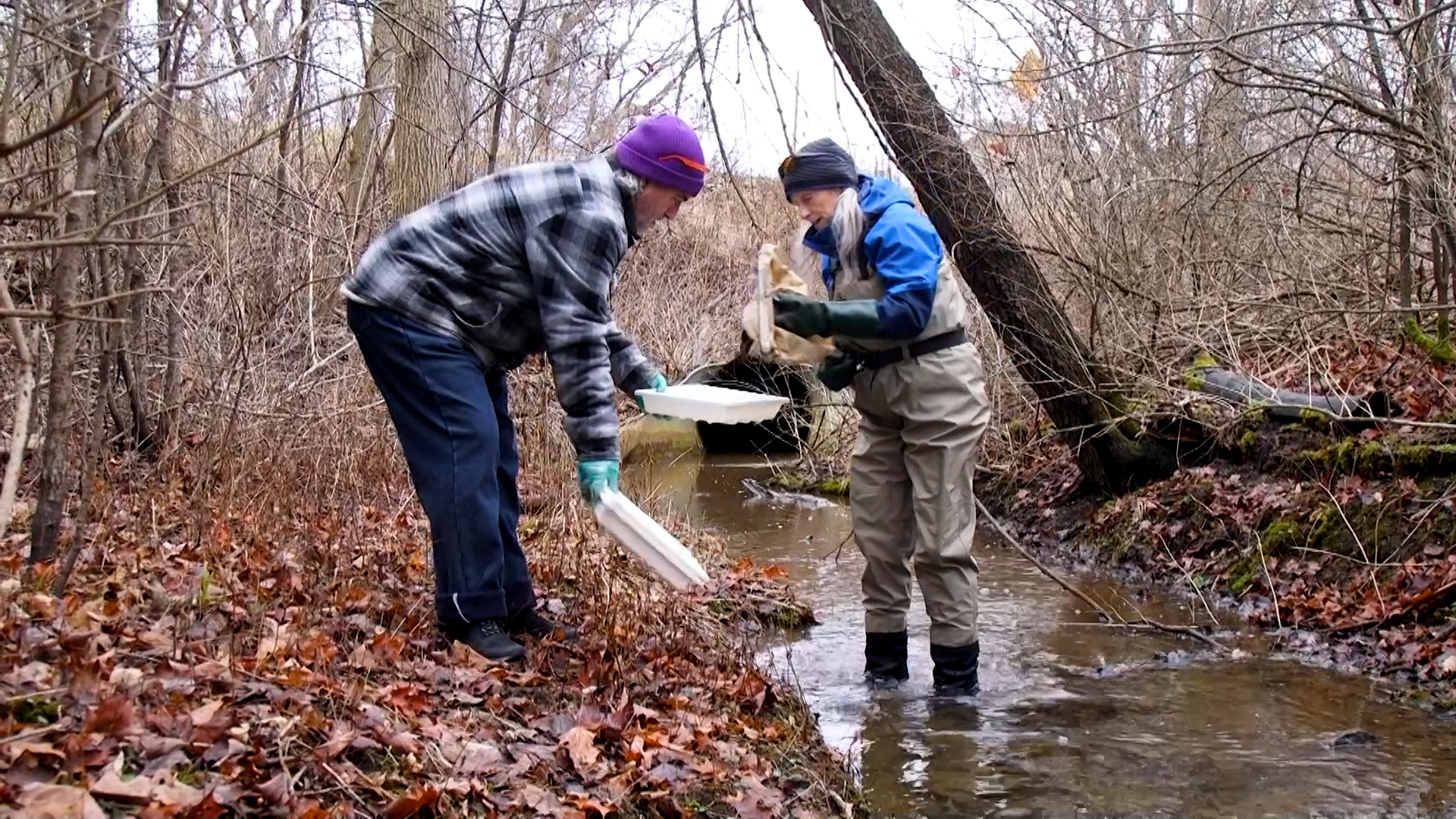
Sally Petrella of Friends of the Rouge collects samples from headwaters of the Rouge River to look for stonefly larva.
Stonefly Survey
SEGMENT 2 | Ypsilanti, Michigan and Detroit, Michigan
A citizen science initiative is in full effect on Detroit’s Rouge River, once one of the most polluted waterways in the Great Lakes.
Every winter Friends of the Rouge, a group dedicated to promoting the restoration and stewardship of the Rouge River, hosts their annual stonefly survey. The stonefly is a pollution-sensitive aquatic insect that calls the Rouge River home. It is also an important environmental indicator. Its absence or presence in the river helps researchers understand current water quality. Most importantly, if stonefly larvae are found, it’s a good thing. Their presence indicates that the river contains clean, well-oxygenated water — all signs of a healthy river.
The annual stonefly survey couldn’t be done without the help of volunteers. According to Friends of the Rouge’s Sally Petrella, “We have a lot of people that really care about the river and want to do whatever that they can to help.”
Join us and a group of passionate Citizen Scientists as we brave the cold and search for stoneflies at a headwater stream in Ypsilanti, Michigan.
Here is other Great Lakes Now work on insects:
The Catch: Why The Lightning Bug Population Is Dimming
Bugs, Shorter Winters, Climate: Great Lakes vineyards face changing circumstances
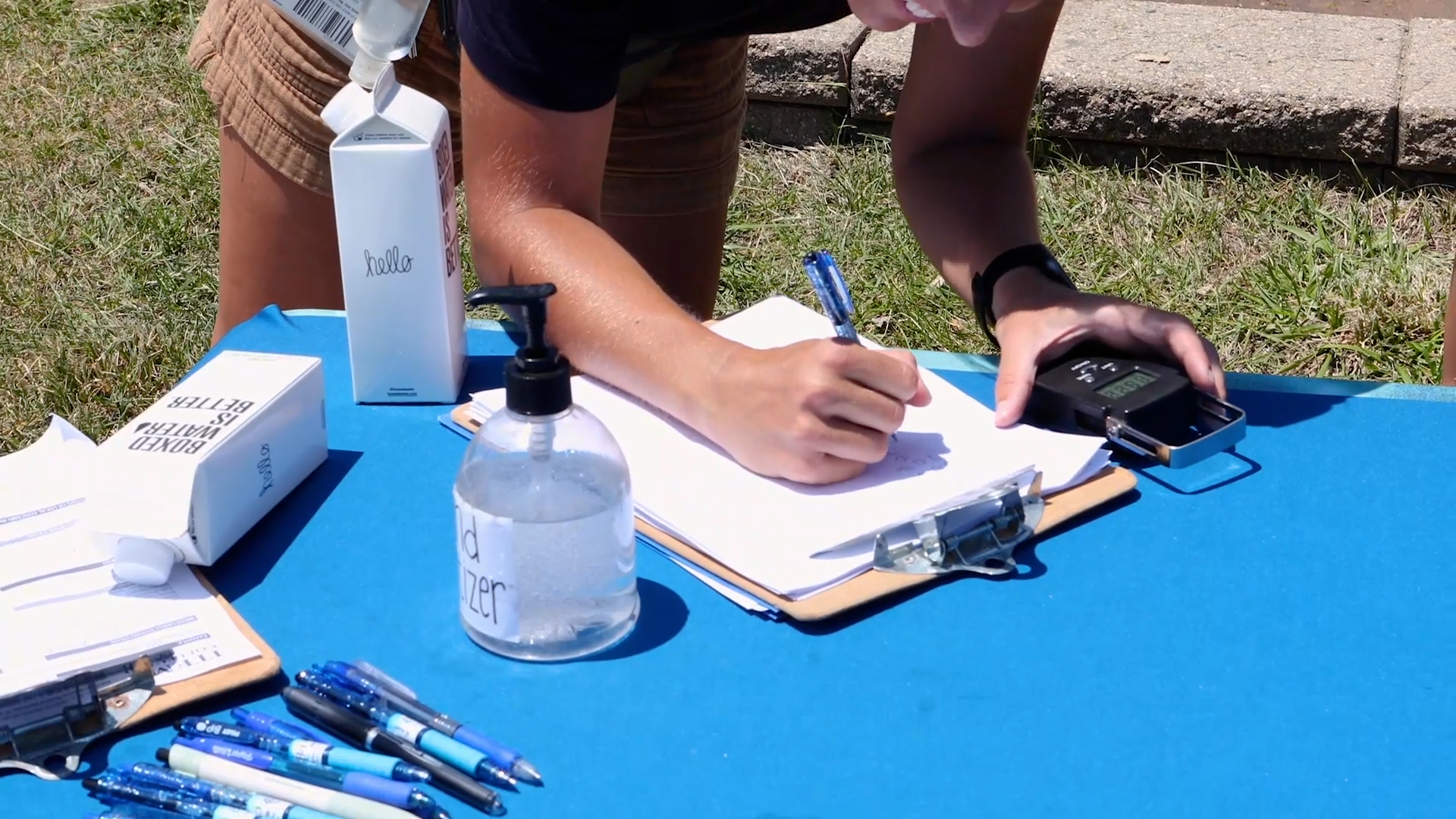
Dr. Melissa Youngquist of the Shedd Aquarium works with volunteers to monitor forests for invasive species in Cook County. The work is part of the aquarium’s Citizen Action Days.
The Catch: News about the Lakes You Love
SEGMENT 3 | Chicago, Illinois; Charity Island, Au Gres, MI
This segment – The Catch – in our award-winning PBS program will keep you in the know. This month, stories about citizen science initiatives from students researching an endangered plant, to an aquarium working on local habitat restoration.
First, a look at popular ongoing citizen science initiatives with Darlene Cavalier, founder of Sci Starter, an online resource for people interested in contributing to scientific data collection. Stream Selfie, iNaturalist and Mosquito Habitat Mapper are a few of the citizen science projects that people can join. These three projects are all Sci Starter affiliates, which means that participants can track their contributions across these, and other citizen science projects supported by Sci Starter.
Next, we head to Chicago’s Shedd Aquarium where citizen science is getting a boost with a series of conservation action days. The program allows people to help improve animal habitats in their own backyards, at the beach or in nearby wooded areas. Krystyna Meyer is coordinator of conservation action at the aquarium and she’s partnered with the Forest Preserves of Cook County to tackle a problematic invasive species. “There is an invasive tree called European buckthorn. As you can tell by the name, it is not native here in the U.S., but it has started to take over our native landscape,” Krystyna said. She and other aquarium staff work with volunteers to hand tools to cut and burn the invasive brush, which helps make room for native flora and fauna.
Finally, Great Lakes Now Contributor Sharon Oosthoek talks about a citizen science initiative involving elementary school students in northeast Michigan. On Charity Island in Saginaw Bay, students are participating in a long-term scientific study focused on an endangered plant species. Sharon wrote about the effort in her latest “Science Says What?” column. “These students are taking part in a study of restoration efforts for the threatened Pitcher’s Thistle,” Sharon said. The collaboration between the students and scientists has been happening every spring since 2015.
Find all The Catch segments HERE.
Videos from Episode 2303
Subscribe on YouTube
Featured Articles
Digital Credits
The Great Lakes Now Series is produced by Rob Green and Anna Sysling.


